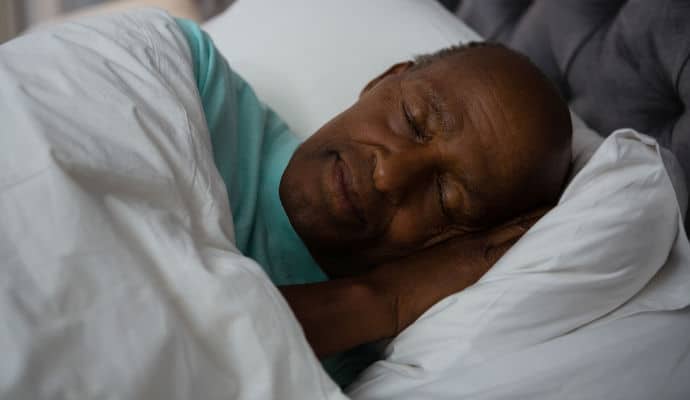As we age, a good night’s sleep becomes increasingly precious yet often elusive, as pain and discomfort frequently disrupt sleep. For seniors dealing with arthritis, chronic pain, or other age-related conditions, finding relief at bedtime can feel like an impossible challenge. But minor, thoughtful adjustments to your sleep environment and routine can make a profound difference.
In this article, we share 11 practical, expert-approved tips to improve sleep for seniors. These tips create optimal sleep conditions, so aging adults can finally enjoy the restorative sleep they deserve. Everyone should wake up feeling refreshed, not exhausted!

Improve Sleep for Seniors and Reap the Rewards
It’s exhausting to wake frequently at night to help an older adult in your care.
But it’s often necessary to ensure they don’t fall, wander out of the house, or accidentally hurt themselves.
There are many reasons why seniors wake at night, but a top one is chronic pain.
And if they’re sleeping in a position that doesn’t properly support their body, it can create extra pressure that increases their pain.
Aligning and supporting the body can help an older adult sleep more comfortably, which can, hopefully, reduce the number of times they (and you) wake up during the night.
We’ve rounded up 11 tips to improve sleep for seniors by adjusting their sleep positions to support their bodies better and reduce nighttime pain.
These tips cover side, back, and stomach sleeping, as well as a variety of health conditions, such as back pain due to spinal issues, neck or hip pain, acid reflux, and more.
Focus on Comfortable Body Alignment to Improve Sleep for Seniors
The goal is to keep an older adult’s body as aligned and neutral as possible while they sleep.
For a younger adult, the spine is straight and the lower back is in its natural, slightly curved position.
However, for older adults, age and chronic health conditions may have led to aches and pains, along with changes in body shape.
A comfortable alignment for them may differ from what works for a younger adult’s body.
For example, seniors with kyphosis (a rounded back) won’t be able to lie flat on their backs. A comfortable sleep position for them may be on their side, with their spine supported as it is (curved), not trying to straighten it.
These tips are starting points to help aging adults find a comfortable sleeping position.
To suit their body and personal preferences, experiment and adjust until you find a position that works well for them.
*It’s always best to check with your doctor before trying something new to avoid any chance of injury.
Note: You can use folded or rolled towels or blankets to get the same effect as pillows. That can help if you’re still experimenting and don’t want to buy extra pillows before you find a comfortable position. Also, this assumes that your older person has a relaxed, supportive mattress.
11 Tips to Improve Sleep for Seniors by Reducing Pain and Discomfort
1. For side sleepers
At 7 minutes 32 seconds in this video, physical therapists demonstrate how to achieve a well-supported sleep position for a side sleeper.
Key points:
- Use enough pillows under the head to keep it in a neutral (middle) position, which keeps the spine aligned from neck to body
- To reduce pressure on the lower shoulder, add a pillow under the torso, leaving space for the arm (8 min 34 sec in video)
- Add a pillow between the knees or lower legs to keep the hips, pelvis, and spine aligned
- To reduce pressure on the upper shoulder, add a pillow under that arm (9 min 20 sec in video)
2. For back sleepers
At 6 min 43 sec in this video, physical therapists demonstrate how to achieve a well-supported sleep position for a back sleeper.
Key points:
- Don’t use too many pillows under the head so the neck isn’t forced to bend forward
- Add a pillow or a leg wedge under the knees to keep the lower back in a neutral position
3. For stomach sleepers or those with degenerative disk disease (VIDEO)
Generally, sleeping on the stomach isn’t recommended because it’s hard on the back, but long-held habits can be challenging to break.
However, stomach sleeping may be helpful for people with degenerative disk disease (see #3 in this list).
This video (above) shows how to give better support while sleeping on the stomach to keep the spine neutral.
Key points:
- Use a skinny pillow under the head or no pillow at all
- Place a thin or medium pillow under the stomach or pelvis
- Bring one leg to the side and slightly bend it, put a pillow under this knee
4. For general back pain
To relieve back pain, it’s best to sleep on the side or back, following the tips in #1 and #2 above.
5. For those who prefer a reclining chair or for isthmic spondylolisthesis
Some older adults might prefer to sleep in a reclining chair.
Sleeping in a reclined position is also helpful for a spinal condition called isthmic spondylolisthesis. That’s where one of the lower vertebrae slips forward onto the bone directly beneath it.
Sleeping in a reclined position (#5 in this list) takes pressure off the spine.
A bed wedge is an inexpensive option that mimics the shape of a recliner chair. An adjustable bed is a more expensive option.
6. For a herniated disk
A helpful sleeping position for back pain caused by a herniated disk is the fetal position, #2 in this list. Sleeping curled up opens the space between the vertebrae.
7. For general neck pain
The best sleeping positions for neck pain are on the back or on the side because they align the neck and spine with the rest of the body.
Use the correct pillow height, following the tips for side and back sleepers in #1 and & 2 above.
It’s best to avoid stomach sleeping because the head is twisted to one side, which can put pressure on neck nerves.
8. For general hip pain
Sleep on the “good” side with knees bent for hip pain. Use the side sleeping tips in #1 above to align the hips, pelvis, and spine.
9. For general knee pain
Sleep on the side or back using the tips in #1 and 2 above to ease knee pain and keep the knee in a comfortable, slightly bent position.
10. For general shoulder pain
To relieve shoulder pain, have your older adult sleep on their back with a small pillow under the painful shoulder.
Or, sleep on the side of the “good” shoulder and follow the tips in #1 above.
11. For heartburn or GERD
To relieve heartburn or GERD discomfort while sleeping, sleep on the left side and use bed risers to elevate the head of the bed and create an incline.
Or, use a bed wedge to put the head and torso on an incline.
Avoid using extra pillows under the head, as this doesn’t put the stomach area on an incline, which helps stomach acid stay down there.
Recommended for you:
- 2 Ways to Solve Senior Sleep Problems So You Can Finally Get Some Rest
- Weighted Blankets for Dementia Improve Sleep and Reduce Anxiety
- 5 Tips to Improve Sleep in Dementia
This article contains affiliate links. We never link to products or services for the sole purpose of making a commission. For more information, see How We Make Money.
About the Author

Connie is the founder of DailyCaring.com and was a hands-on caregiver for her grandmother for 20 years. (Grandma made it to 101 years old!) She knows how challenging, overwhelming, and all-consuming caring for an older adult can be. She also understands the importance of support, especially in the form of practical solutions, valuable resources, and self-care tips.












